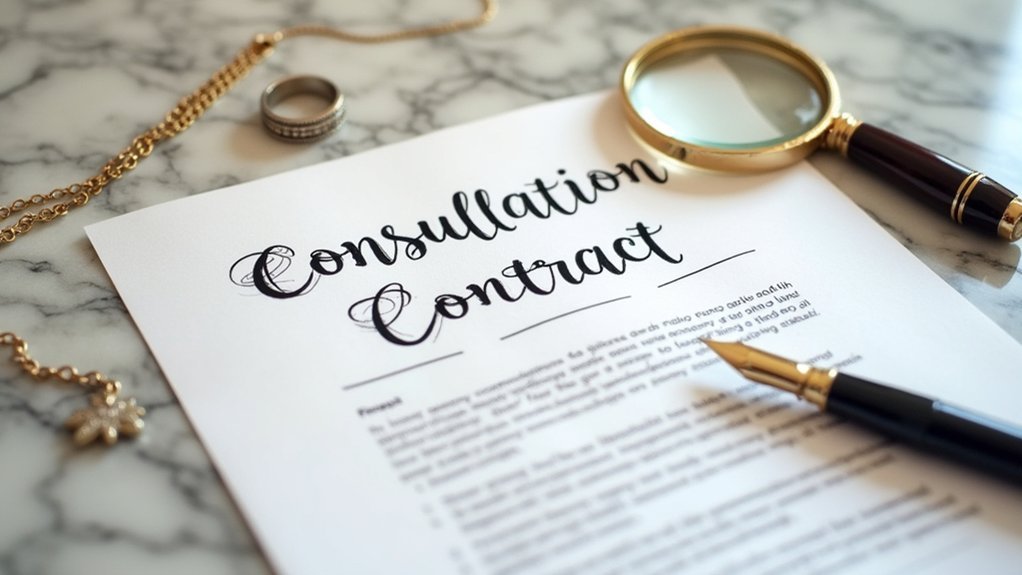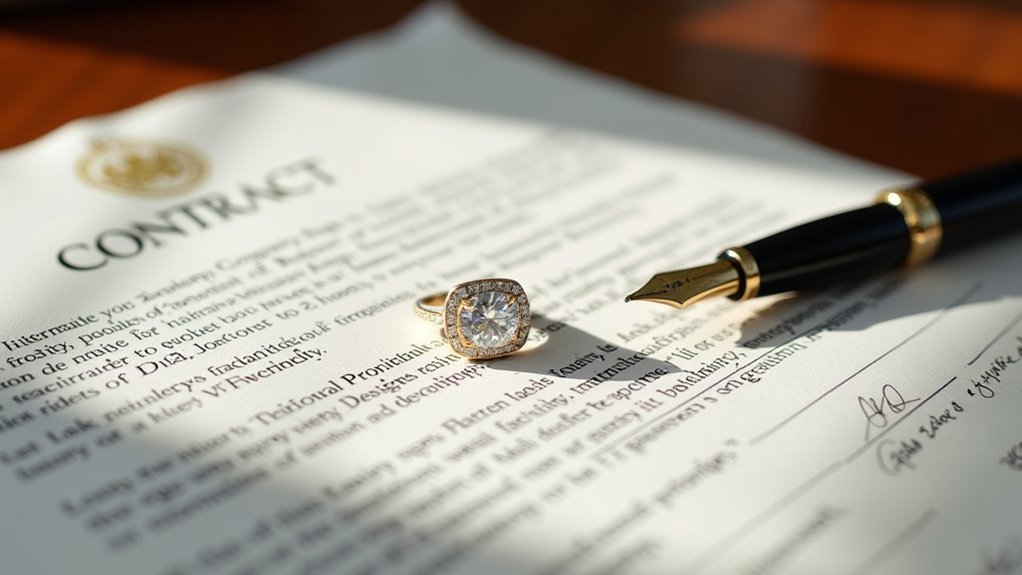You’re about to invest thousands in a custom jewelry piece, but without the right contract elements, you could end up losing both your money and your design. Most jewelry consultation agreements lack three critical components that protect both parties from costly disputes and misunderstandings. These missing elements have led to countless legal battles, delayed projects, and broken client relationships that could’ve been easily prevented.
Clear Scope of Consultation Services and Deliverables

Successful jewelry consultation contracts begin with a thorough scope that outlines exactly what services you’ll provide and what clients can expect to receive.
Your clear scope of consultation services should specify whether you’re offering design consultations, gemstone selection, or repair assessments. Define your deliverables with precise timelines for each consultation phase, so clients know when to expect updates.
Clearly define your consultation offerings and deliverable timelines to ensure clients understand exactly what services they’re receiving and when.
Establish milestones throughout the process to track progress and accommodate client feedback. Include detailed reports documenting consultation outcomes and recommendations as standard deliverables.
Equally important, explicitly state services not included in your responsibilities. This prevents misunderstandings and sets realistic expectations from the start, protecting both you and your clients.
Payment Terms and Fee Structure for Design Services
Three essential components form the foundation of effective payment terms in jewelry consultation contracts: your fee structure, payment schedule, and expense reimbursements policies.
Your contract must specify design services costs, including consultation fees, design fees, and material expenses. This legally binding document protects both parties involved by establishing clear expectations.
You’ll need to determine whether payments occur weekly, monthly, or milestone-based, depending on project complexity. Flexibility in payment terms can guarantee mutual satisfaction between you and your client.
Don’t forget to outline timing for expense reimbursements throughout the design process.
Transparent payment terms foster trust and strengthen your business relationship with clients, preventing costly misunderstandings that could derail projects.
Intellectual Property Rights and Design Ownership

When you create original jewelry designs during a consultation, establishing clear intellectual property rights becomes essential for protecting both your creative work and your client’s investment.
The contract must contain specific provisions detailing design ownership to prevent future legal issues. A valid contract requires exchange of value where intellectual property transfers occur upon project completion.
The terms of the contract should address these critical elements:
- Ownership transfer – All design rights transfer to the client after final payment
- Usage restrictions – Consultant can’t reuse designs for other projects without permission
- Copyright protection – Clear definitions of trademark and copyright handling
- Scope boundaries – Specific limitations on design usage and modification rights
Parties must understand these provisions fully, and consulting legal advice guarantees the agreement protects your interests while maintaining enforceability.
Frequently Asked Questions
What Are the 3 Essential Elements of a Contract?
You’ll need three essential elements for any valid contract: a clear offer specifying terms, acceptance without modifications, and consideration where both parties exchange something of value between them.
What Are the 3 P’s of a Contract?
You’ll find the three P’s are Parties, Purpose, and Performance. You need all parties with legal capacity, a lawful purpose that’s enforceable, and clearly defined performance obligations that each party must fulfill.
What Are the Three 3 Required Elements to Create a Valid Contract?
You’ll need offer, acceptance, and consideration to create a valid contract. You must make a clear proposal, the other party must accept it, and both sides must exchange something of value.
What Should a Consultant Contract Include?
You’ll need scope of work, payment terms, confidentiality agreements, intellectual property rights, and termination clauses. These elements protect both parties and guarantee clear expectations throughout the consulting relationship.
In Summary
You’ll protect both your business and client relationships by including these three critical elements in every jewelry consultation contract. Don’t overlook the importance of clearly defining your services, establishing transparent payment terms, and securing intellectual property rights. These components aren’t just legal formalities—they’re your foundation for successful, dispute-free collaborations. Take time to craft thorough contracts that address each element thoroughly. Your future self will thank you for this attention to detail.





Leave a Reply